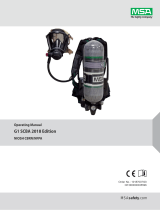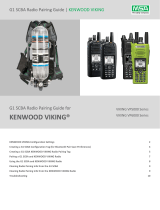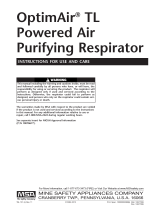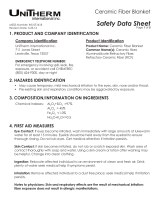Page is loading ...

SAFETY DATA SHEET
D-127 CITRUS PRESSURE WASHER DEGREASER
1. IDENTIFICATION
Product Code : D-127
Product Name : Citrus Pressure Washer Degreaser
Packaging Size : 4 L Jug (4 x 4 L in one case)
Packaging Code : 8581936
Synonyms : Citrus Degreaser
Recommended Use : Cleaner and Degreaser
Restrictions on Use : For Industrial and Commercial Use Only
Supplier Identifier : Aaladin Superior Cleaning Systems, Ltd.
71 Don Valley Parkway
PO Box 62052 Transcona RPO
Winnipeg, MB R2C 5G2
Canada
Phone: (204) 663-6618 Fax: (204) 663-3125
Emergency Telephone Number (CANUTEC): (613) 996-6666
2. HAZARD IDENTIFICATION
Classification:
Acute toxicity, oral (Category 4)
Symbol:
Signal Word:
Warning
Hazard Statements:
May cause irritation to eyes, skin and lungs.
Harmful if swallowed,
Precautionary
Statements:
Wear protective gloves/protective clothing/eye protection/face protection.
Wash face, hands and exposed skin with plenty of water after handling.
Do not eat, drink or smoke when handling this product.
Do not breathe mist/vapor.
Call immediate medical attention when severely exposed.
Other Hazards Not
Classified:
Not Applicable
3. COMPOSITION/INFORMATION ON INGREDIENTS
Ingredients
Percentage (w/w)
Glycol Ether EB (CAS#: 111-76-2)
1 to 5
D-Limonene (CAS# 5989-27-5)
1 to 3
Sodium Xylene Sulfonate (CAS#: 1300-72-7)
1 to 3
Cocoamide DEA (CAS#: 68603-42-9)
3 to 6
Pigment
<1
Water (CAS#: 7732-18-5)
>80
4. FIRST-AID MEASURES
First Aid Measures by Route of Exposure:
Inhalation: Move victim to fresh air. Seek medical attention if adverse effects occur.
Skin Contact: Wash the affected area with plenty of slow flowing water. If irritation persists, seek medical attention.
Eye Contact: Wash eye with plenty of water until irritation is gone. Seek medical attention if irritation persists.
Ingestion: May cause upset stomach. Drink plenty of water to dilute. Seek medical attention.
First Aid Comments: All first aid procedures should be periodically reviewed by a doctor familiar with the chemical and its conditions of
use in the workplace.
Most Important Symptoms and Effects (acute or delayed): Not Available
Immediate medical attention and special treatment needed, if necessary: Treat symptomatically.
5. FIRE-FIGHTING MEASURES
Suitable Extinguishing Media: Not combustible. Use extinguishing agent suitable for surrounding fire.
Unsuitable Extinguishing Media: Not Applicable
Specific Hazards Arising from the Chemical: Toxic sodium oxide fumes can be generated at high temperatures.
Hazardous Combustion Products: Not Applicable
Special Protective Equipment and Precautions for Fire-Fighters: Wear self-contained breathing apparatus and full protective gear.

6. ACCIDENTAL RELEASE MEASURES
Personal Precautions: Remove or isolate incompatible materials as well as other hazardous materials.
Methods for Containment and Clean-up: Contain and soak up spill with absorbent that does not react with spilled product. Flush spill
area. Dike spilled product to prevent runoff.
7. HANDLING AND STORAGE
Precautions for Safe Handling: Wear protective equipment. Ensure adequate ventilation. Keep away from heat, sparks, open flame and
direct sunlight. Keep containers tightly closed when not in use or empty. Do not eat, drink or smoke while handling this product.
Conditions for Safe Storage: Store in an area that is: cool, dry, well-ventilated, separate from incompatible materials. Keep amount in
storage to a minimum. Store in the original, labelled shipping container. Vent drums to prevent pressure buildup. Do not handle swollen
drums. Get expert advice.
8. EXPOSURE CONTROLS/ PERSONAL PROTECTION
Control parameters, including occupational exposure guidelines or biological exposure limits and the source of those values: No
exposure limits
Appropriate Engineering Controls: Use a local exhaust ventilation and enclosure, if necessary, to control amount in the air. Exhaust
directly to the outside, taking any necessary precautions for environmental protection. Eye wash facility and emergency shower must be
available when handling this product.
Individual Protection Measures:
Eye/Face Protection: Wear chemical safety goggles. A face shield (with safety goggles) may also be necessary.
Skin Protection: Wear chemical protective clothing e.g. gloves, aprons, boots. Suitable materials include: butyl rubber, natural rubber,
neoprene rubber, nitrile rubber, polyethylene, polyvinyl chloride, Viton®, Viton®/butyl rubber, Barrier® (PE/PA/PE), Silver Shield/4H®
(PE/EVAL/PE), Trellchem® HPS, Trellchem® VPS, Tychem® SL (Saranex™), Tychem® BR/LV, Tychem® Responder, Tychem® TK.
Respiratory Protection: Up to 10 mg/m
3
: wear a NIOSH approved air-purifying respirator with N100, R100, or P100 filter(s), wear a
NIOSH approved self-contained breathing apparatus (SCBA) or supplied air respirator. ESCAPE: wear a NIOSH approved air-purifying
respirator with N100, R100, or P100 filter(s), wear a NIOSH approved self-contained breathing apparatus (SCBA) or supplied air respirator.
9. PHYSICAL AND CHEMICAL PROPERTIES
Physical State: Liquid Colour: Orange Odor: Pleasant Citrus Scent
Odor Threshold: Not Available pH: Alkaline Freezing Point: 0
o
C approx.
Initial Boiling Point/Boiling Range: Above 100
o
C Flash Point: Not Available
Evaporation Rate: Not Available Flammability (solid; gas): Not Available
Lower Flammable/Explosive Limit: Not Available Vapour Pressure: Not Available
Upper Flammable/Explosive Limit: Not Available Vapour Density: Not Available
Relative Density: Not Available Solubility: Completely Soluble
Partition Coefficient – n-octanol/water: Not Available Viscosity: Not Available
Auto-ignition Temperature: Not Available Decomposition Temperature: Not Available
10. STABILITY AND REACTIVITY
Reactivity: Not available
Chemical Stability: Stable
Possibility of Hazardous Reactions: None under normal processing
Conditions to Avoid: Water, moisture or humidity, generation of mists and dust.
Incompatible Materials: Highly reactive. Reacts violently with organic acids (e.g. acetic acid), inorganic acids (e.g. hydrofluoric acid),
oxidizing agents (e.g. peroxides).
Hazardous Decomposition Products: Oxides of sodium
11. TOXICOLOGICAL INFORMATION
Information on the Likely Routes of Exposure: Skin contact, Eye contact.
Inhalation: Not expected to be an inhalation hazard unless it becomes an airborne dust or mist. May cause irritation of the nose and
throat.
Skin Contact: Not expected to cause irritation.
Eye Contact: May cause mild irritation.
Ingestion: May cause stomach upset. Symptoms may include nausea, vomiting, stomach cramps and diarrhea. Can cause death.
Effects of Long-Term (Chronic) Exposure: Not Available.
Carcinogenicity: Not known to cause cancer.
International Agency for Research on Cancer (IARC): Not specifically designated.
American Conference for Governmental Industrial Hygienists (ACGIH): Not specifically designated.
Teratogenicity / Embryotoxicity: Not known to harm the unborn child.
Reproductive Toxicity: Not known to be a reproductive hazard.
Mutagenicity: Not known to be a mutagen.
12. ECOLOGICAL INFORMATION
Ecotoxicity: Not available Persistence and Degradability: Expected to be biodegradable.
Bioaccumulative Potential: Not Available Mobility in Soil: Not Available

Other Adverse Effects: No adverse environmental effects are expected from this product.
13. DISPOSAL CONSIDERATIONS
Waste Disposal Methods: Disposal of all wastes must be done in compliance with federal, provincial and local regulations. Liquid
residues must be properly neutralized to pH 6 – 9 then may be disposed off in waste water treatment facilities which allow the discharge of
neutral salt solutions.
Contaminated Packaging: Empty containers should be recycled or disposed off through an approved waste management facility.
14. TRANSPORT INFORMATION
UN Number: Not Applicable UN Proper Shipping Name: CLEANING COMPOUND Transport Hazard Class: None
Packing Group: II Environmental Hazards: Not Available Transport in Bulk: Not Available
Special Precautions:
15. REGULATORY INFORMATION
Canadian DSL Inventory Status: All components of this product are either on the Domestic Substances List (DSL), the Non-Domestic
Substances List (NDSL) or exempt.
16. OTHER INFORMATION
Prepared by: JAIME CORPUZ
71 Don Valley Parkway
PO Box 62052 Transcona RPO
Winnipeg, MB R2C 5G2
Canada
Phone: (204) 663-6618 Fax: (204) 663-3125
Date Prepared: 25 Jun 2018
General Disclaimer: The information provided on this SDS is correct to the best of our knowledge, information and belief at the date of
its publication. The information provided is for the purpose only as a guide for safe handling, use, processing,
storage, disposal and release. It is not to be considered as a warranty or quality specification.
To the best of our knowledge, the information contained herein is accurate. However, neither the supplier nor any
of its subsidiaries assumes any liability whatsoever for the accuracy or completeness of the information contained
herein. Final determination of suitability of any material is the sole responsibility of the user. All materials may
present unknown hazards and should be used with caution. Although certain hazards are described herein, we
cannot guarantee that these are the only hazards that exist.
Aaladin Superior Cleaning Systems expressly disclaims all expressed or implied warranties of merchantability and
fitness for a particular purpose with respect to the product provided.
/





